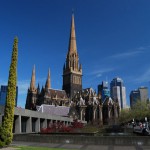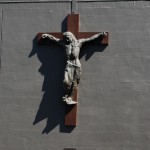Saint Patrick’s Cathedral in Melbourne
Founded in 1835, Melbourne experienced active growth due to the Gold rush, which took over the entire Green Continent in the early 1850s. Since 1851, the population of a small in those times town began to increase rapidly. Thousands of goldminers rushed here from all over the world hoping to find their fortune. Among them there were many immigrants from Ireland, still a relatively poor marginal province of the British Empire. It was them, who brought to Melbourne the cult of Saint Patrick; and it was to Saint Patrick that the first Catholic church of Melbourne was devoted to.
The Cathedral’s construction started in 1858. The project’s author was William Wilkinson Wardell, an ardent worshipper of the Gothic style and of the grand-scale architecture. No wonder he proposed to erect a huge neo-Gothic cathedral in Melbourne, which would overshadow in its dimensions everything built by man on the land of the Green Continent. In the process of construction, Wardell had to make some changes in the project, but still St Patrick’s Cathedral in Melbourne is unanimously acknowledged to be the most beautiful ecclesiastic building in Australia.
The cathedral’s construction lasted for forty years. Beginning from 1868, worship services were held in its nave. Consecrated in October of 1897, St. Patrick’s Cathedral became the largest ecclesiastic building of the XIX century. Its dimensions are as follows: it is 103.6 meters long; 56.38 meters wide; the nave’s width is 25.29 meters, the height of the nave and transepts – 28.95 meters.
Saint Patrick’s Cathedral is built with blocks of bluestone, and window frames, decorative balustrades, buttresses and spires – with lighter creamy blocks. Like almost all large cathedrals, in layout it has the shape of a Latin cross, spacious central nave, transept, choir, surrounded by a crown of seven chapels and a sacristy. The nave is built in the architectural style, which is close to Early English; other sections of the building are maintained in the spirit of so called “decorated Gothic.” The choir, central nave and transept are spanned with a high steep roof.
The cathedrals’ creator, William Wilkinson Wardell died two years after the cathedrals’ consecration. Decorative works in the cathedral continued for twenty more years. To the credit of the architect’s successors, they refused the idea to try to adorn the cathedral with stained glass windows, except for the stained glass in the chapels; and kept the amber glass windows, because of which the interior space of the cathedral is lit with the shimmering golden light. The floor is decorated with mosaic tiles. Mosaics produced in Venice were also used to decorate the altar made of marble and alabaster. West rosette-window is the only one that has stained glass. It was made in Birmingham (England) and it portrays the scene of Ascension.
In 1937-1939, the cathedral’s silhouette was completed by three towers, envisaged by Wardell’s project. The height of two twin-towers of the west façade is 61.87 m. The tower over the middle crossing, square in the lower tier and illumined by a row of narrow arrow-shaped windows is topped by an elegant multi-faceted construction, which is crowned with a spire that looks like a thin long arrow. Its height is 79.25 meters. Celtic Cross on top of the central spire was donated by the Irish government and weighs around 1 500 kilograms.
An organ of 4,500 pipes was installed in the cathedral in 1964 and it is one of the best organs in Australia. Perfect acoustics of the cathedral allows to hold in it regular concerts of leading musicians and choir groups, that enjoy huge popularity. In 1997, for the centenary of the cathedral’s consecration, it was upgraded; and now it fulfills its main function, being the leading religious and social center of South Australia.
Saint Patrick’s cathedral in Melbourne is one of the five Australian temples having the title and dignity of Minor Basilica.
In 1970, Pope Paul VI became the first Pope to visit the cathedral. In 1974, Pope Paul VI conducted a service in the minor basilica of the cathedral. In 1986, Saint Patrick’s cathedral in Melbourne was visited by Pope John Paul II.
The article is based on information from encyclopedia “The World’s Greatest Temples” – Moscow, “Veche,” 2006.




